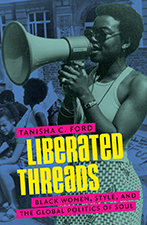Spanx and The Marketing of "Normal" in a Fatphobic Culture
 By now you’ve likely heard of Sara Blakely’s 21st century girdle alternative, Spanx. Perhaps you’ve even tried them out, or like me, don them religiously—with everything. Just to be clear, this is not a testimonial for Spanx or a rendition of “Oprah’s Favorite Things.” See, while I wear Spanx religiously, like many others, I do so in response to the societal pressure to perform “thinness.” I already know what you’re thinking: no one is forced to do anything. This is true to a degree. However, just to put it out there I will say this: no one forces me to wear Spanx, especially not religiously. The truth is, Spanx makes me feel better—regardless of my size, which admittedly fluctuates. The issue is I’ve come to believe that I need them—in spite of BMI.
By now you’ve likely heard of Sara Blakely’s 21st century girdle alternative, Spanx. Perhaps you’ve even tried them out, or like me, don them religiously—with everything. Just to be clear, this is not a testimonial for Spanx or a rendition of “Oprah’s Favorite Things.” See, while I wear Spanx religiously, like many others, I do so in response to the societal pressure to perform “thinness.” I already know what you’re thinking: no one is forced to do anything. This is true to a degree. However, just to put it out there I will say this: no one forces me to wear Spanx, especially not religiously. The truth is, Spanx makes me feel better—regardless of my size, which admittedly fluctuates. The issue is I’ve come to believe that I need them—in spite of BMI.
However, before making a clarion call to revoke my “feminist card” for collaborating in this complex aspect of consumer culture, please note that while I am an admitted consumer of what might be read as an anti-feminist product by some, I am troubled by what makes Spanx a necessity for me (and many others) in the first place. We live in a fat hating culture, which teaches us early on that socially defined “excess,” must be disguised if it cannot be done away with. Of course this impacts both women and men. However, the literal hatred of “fat” likely affects women most—not because we are more “fat” or because we characteristically have higher BMI’s, but because women’s value continues to be measured by sex appeal and beauty standards developed within warped, male-centric formulas for desirability.
Some of you may be thinking, “Its just Spanx! If you don’t like them then don’t buy them!” Sure. That’s the easy response. It puts the onus on me (and other women) and more importantly, shuts down conversation about a very real issue: the hatred of “excess” and continued policing of women’s bodies. Yes, I know that Blakely is a woman. And, yes, I know that she initially designed her product with “women in mind.” And yes, I realize that Spanx now has a line just for men. However, all of this is beside the point. The point is this: there is a market for Spanx because underneath Blakely’s invention are politics of fat, which regulate what’s desirable and what’s not for consenting women and men. At minimum, this assumes that there is a “normal.” Unfortunately, anything that fails to measure up gets reimagined as deviant—at least until it is properly contoured.
To be sure, there is nothing wrong with desiring and/or wanting to appear desirable. However, there is something deeply troubling about my desirability being measured by some sort of corporate formula. Moreover, the reality that bodies, which defy the so-called ordinary, get punished for doing so, is downright vexing! There is a market for Spanx because “fat” is intolerable, particularly for women. Spanx’s “contouring” mechanism makes fat less disruptive and women more appealing—to men. Period.
A few weeks ago Miller-McCune published a story entitled, “Thinner Wife, Happier Marriage,” that argued that heterosexual women are happier as long as they are thinner than their partners. Not only are they happy, their partners are happy! Why? Because they meet the standard of desirability. In a nutshell, being “fat” not only makes you less desirable to men, it makes you unhappy—because happiness depends on male approval. Right. What was even more interesting were the “related stories.” Combined, they communicated the following: women, if you don’t shape up and at least become smaller than your man, you will not only be unhappy because he is unhappy, you will be miserable because he will cheat on you—with not just another woman, but perhaps a man! Great—an appeal to homophobia. This is clearly a deployment of one social fear to combat another. Obviously, it’s supposed to make women race to the gym, fix what’s wrong and start being women—because men can’t be men when their woman is bigger than they are.
To be fair, this story was supposed to be liberative, particularly for women with eating disorders. Thus, it was meant to lessen the pressure for women trying to be “extremely” thin. Thank goodness that’s no longer necessary! Now, women only need to focus on being a little thin—at least thinner than their partners so that they, I mean we (women), can be happy. I should also note that I am not negating the very serious consequences of having poor health. I realize that there are many. However, identity markers such as “fat” and “thin” do not necessarily convey poor or good health either way. Both “fatness” and “thinness” are inherited ideals, which many of us consume and reproduce. In this way, we become co-agents of our own assault, often concealing our dis-ease with “fat” while trying to become “normal.” I am not excluded.
To Spanx or not, is a choice—one guided by fatphobia and the pressure to feel and appear “normal,” but nevertheless a choice made by consumer’s who can afford Spanx (because they are pricey!). This even includes pregnant women. Just recently, Blakely unveiled Mama Spanx, “footless slimming apparel,” invented so that women don’t appear fat can maintain a semblance of their pre-pregnancy curves so that they are desirable while expecting because being “with child” is not sexy to their partners. The pressure to perform thinness abounds—even while pregnant.
But, what of choice? While the politics of fat are forceful and active, women have the right to choose their own representation. Self-representation is a basic condition of freedom. That being said, I make no promises to hold a Spanx burning rally in the future as a sign of my liberation from fatphobia and the desire to be “normal.” However, what I will promise is this: I will continue raising critical questions of not only my own fatphobic complexity, but also of the broader social issue—that being “fat” is an ideological fact, inseparable from the bipolarity and asymmetry of falsely universalized ideas of “normal.” And, it is a “fact” too often masked in the rhetoric(s) of heath and difference. More often than not, the policing of women’s bodies have very little, if anything at all, to do with health. I’ve never seen a headline that read, “so and so is getting unhealthy.” Emphasis is almost always placed on aesthetics and desirability. Thus, we are more likely to see a headline that reads, “so and so is eating pizza again” or “so and so has lost her appeal.”
A recent statement by Rush Limbaugh regarding First Lady, Michelle Obama’s body, is telling. While pointing out Obama’s decision to eat ribs, which have “1,500 calories a serving with 141 grams of fat per serving” while on vacation, Limbaugh ridiculed her for not “project[ing] the image of women that you might see on the cover of the Sports Illustrated Swimsuit Issue or of a woman Alex Rodriguez might date every six months.” Clearly, Limbaugh has in mind a “universal woman” whose beauty is in constant service to the male gaze. Obviously, white men, SI, and Rodriguez set the standard. However, what Limbaugh’s comments also reveal is his time spent with representations of Obama’s body. He had to look her over–several times and thoroughly–before making any kind of judgment. Although he ultimately decided that she was too “fat” for SI or Rodriguez, I wonder how long it took him to make his decision and what kinds of tools were necessary in making it and why?
Of course he was trying to also say that Obama is a hypocrite for eating ribs and being “fat” (which, whatever “fat” is, she is not, by the way), particularly while leading a nationwide anti-obesity campaign. However, in addition to using the “fat” slur to signal untrustworthiness, and un-welcomed pushiness, both of which he likely believes are typical of most black women (clearly there are numerous stereotypes at work here), there seems to be something else going on, perhaps Limbaugh’s fascination with Obama’s body. Ridiculing her bottom (because that’s likely the “evidence” for his claims) provides an alibi for gazing upon it in the first place. Calling Obama and other women “fat” is a shaming tactic. It aims to put women in their place. The question is, exactly what place is that?




6 Comments